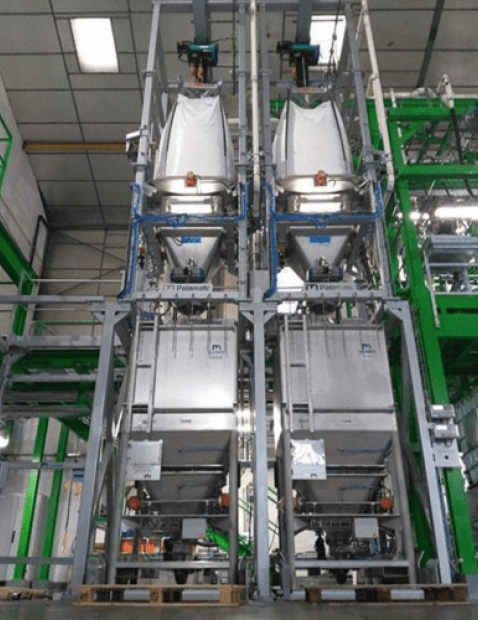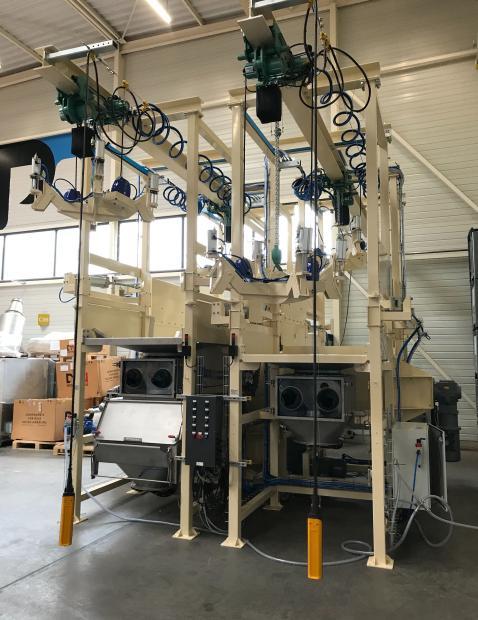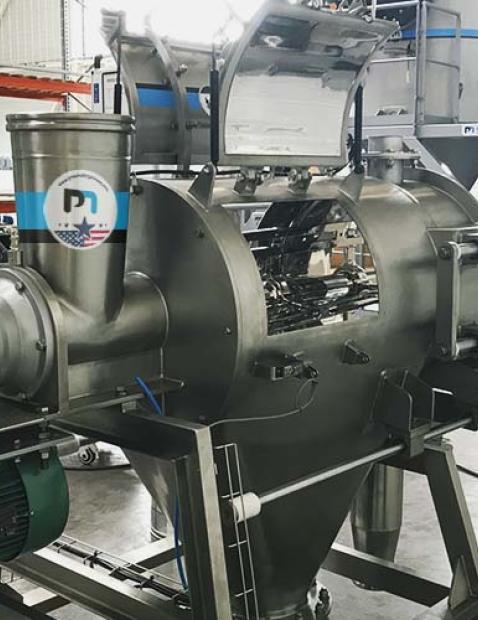What are the differences between NFPA 70 NEC, ATEX and IEC Ex Rated Equipment for Hazardous Locations?

As manufacturer’s have increased access to a global economy, the different regulatory bodies and certifications for industrial process equipment can understandably create a lot of confusion. Let’s look at each one separately, what they mean, and how best to incorporate them into your production process.
1. What is NFPA 70 NEC?
In the U.S.A., regulatory bodies have adopted the National Fire Protection Association (NFPA) 70®, National Electric Code® (NEC) to establish a hazardous classification system for electrical equipment. The NFPA 70 NEC uses a system that designates hazardous area by Classification, Division and Group. It has also added a version of the International Electrochemical Commission’s, more commonly known as IEC Zone system (more to come on this later) which maintains the NEC wiring and protection methods.
NFPA 70 NEC has established hazardous zones and classifications based on Classes, Divisions and Groups that when combined, define the conditions of a specified production area. This provides the manufacturer with the needed information to source equipment that will operate safely within the designated area. The primary purpose of these designations is to prevent explosions within the equipment and surrounding atmosphere to protect workers.
The classification of this rating system defines what type of flammable material is present in the area. For example, Class I designates flammable gases and/or vapors are present in the environment. Class II designates that combustible powders can be present, and Class III if used for fibers and flyings that can be easily ignited.
Divisions determine the concentration, or how often the flammable sources are present in the atmosphere. Division 1 is used when these conditions are present under normal operation conditions. Basically, the area of operation has flammable or combustible materials in the atmosphere all or most of the time. Division 2 is used when these conditions are not typically present in the atmosphere, or are unlikely to occur. A typical Classification and Division chart would look something like this:
NFPA 70 NEC Hazardous Locations Classes, Divisions and Groups
| Class | Division | Group |
|---|---|---|
| I - Flammable gases or vapors may be present |
1- Ignitable concentrations exist some of the time or all of the time under normal operation conditions. |
A - Acetylene |
| II- Combustible dust may be present | 1- Ignitable concentrations exist some of the time or all of the time under normal operation conditions. 2- Ignitable concentrations are not likely to exist under normal operation conditions, but can occur infrequently. |
E - Metal dust F - Coal dust G - Grain Dust |
| III - Ignitable fibers or flying may be present | 1- Ignitable concentrations exist some of the time or all of the time under normal operation conditions. 2- Ignitable concentrations are not likely to exist under normal operation conditions, but can occur infrequently. |
None Specified |
The Occupational Safety and Health Administration (OSHA) adopted these hazardous classifications (except the groups) as defined in the 29 Code of Federal Register (CFR) 1910.399. In 29 CFR 1910.307(c)(2)(ii), OSHA requires all equipment used in a hazardous location be marked with the class, division and operating temperature for which it is approved. One interesting thing to note, according to 1926.407(b)(2)(ii)(A), “equipment of the non-heat-producing type (such as junction boxes, conduit, and fitting) and equipment of the heat-producing type having a maximum temperature of not more than 100 degrees C (212 degrees F) need not have a marked operating temperature or temperature range”.
OSHA will accept equipment as long as it has a specific mark by one of the NRTLs (Nationally Recognized Testing Laboratory) on it. For a list of NRTLs see this link.
2. What is ATEX?
The acronym ATEX stands for atmospheres explosibles, and is an EU directive from the European Committee for Standardization that regulates “equipment and protective systems intended for use in potentially explosive atmospheres”. As with the U.S. NFPA 70 NEC system, ATEX is intended for atmospheres that can be explosive for reasons including flammable gases, vapors or combustible dusts.
Just like with the NEC in the United States, all equipment used in potentially explosive atmospheres in the EU must meet ATEX health and safety requirements. Equipment manufacturers are responsible for making sure their equipment complies with ATEX standards. The certification process involves conformity assessment procedures by a third party referred to as the “Notified Body”. Certified equipment will be marked with this symbol:
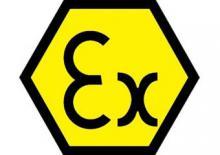
There is overlap and the equivalency of both the ATEX and NFPA 70 systems. However, it is important to note that they are regulated by different governing bodies. Instead of using classification and division designations, the ATEX system uses zones based on the presence of flammables or combustibles in the atmosphere. Zones are broken down as follows:

If your require further assistance,
I am at your entire disposal.
Tarik, powder expert
ATEX zones for gases/vapor:
Zone 0: an area in which an explosive mixture is continuously present or present for long periods.
Zone 1: an area in which an explosive mixture is likely to occur in normal operation.
Zone 2: an area in which an explosive mixture is not likely to occur in normal operation and if it occurs it will exist only for a short time.
ATEX zones for dust:
Zone 20: an area in which an explosive mixture is continuously present or present for long periods.
Zone 21: an area in which an explosive mixture is likely to occur in normal operation.
Zone 22: an area in which an explosive mixture is not likely to occur in normal operation and if it occurs it will exist only for a short time.
A typical ATEX zoning chart would look like this:
| Flammable Material | Present Continuously | Present Intermittently | Present Abnormally |
|---|---|---|---|
| Gas / Vapor | Zone 0 | Zone 1 | Zone 2 |
| Combustible Dust or Fibers | Zone 20 | Zone 21 | Zone 22 |
3. What is IECEx?
The IEC Ex system stands for International Electrochemical Commission Explosive. While ATEX is mandatory in Europe for explosive atmospheres, and NFPA 70 for the U.S., IECEx is an international certification accepted in several countries. It was designed to eliminate confusion between the two main existing explosion rating systems and foster international trade for equipment to be used in potentially explosive atmospheres.
This international system has several benefits:
- Can result in reduced testing and certification costs
- Easier path to global markets and sourcing for manufacturers
- Establishes confidence in selecting equipment from international suppliers
The good news for U.S. manufacturers is that the U.S.A is a participating country in the IECEx system via the American National Standards Institute (ANSI). From OSHA’s perspective, NRTL’s have a path towards recognizing the IECEx system, “New procedures for the acceptance of inspections and test data from organizations that function as part of the International Electrotechnical Commission System for certification to standards relating to equipment for use in Explosive Atmospheres (IECEx Scheme)”. (OSHA Instruction).
A conceptual comparison chart may look something like the following (please note, due to some overlap in regulations, this chart is not precise but an approximation):
| Atmosphere | ATEX Category | Zone | IEC Protection Level | NEC Classification | NEC Division |
|---|---|---|---|---|---|
| GAS | 1G | 0 | Ga | Class I | Division 1 |
| GAS | 2G | 1 | Gb | Class I | Division 1 |
| GAS | 3G | 2 | Gc | Class I | Division 2 |
| DUST | 1D | 20 | Da | Class II | Division 1 |
| DUST | 2D | 21 | Db | Class II | Division 1 |
| DUST | 3D | 22 | Dc | Class II | Division 2 |
Example of a name plate showing all zone and classification designations:
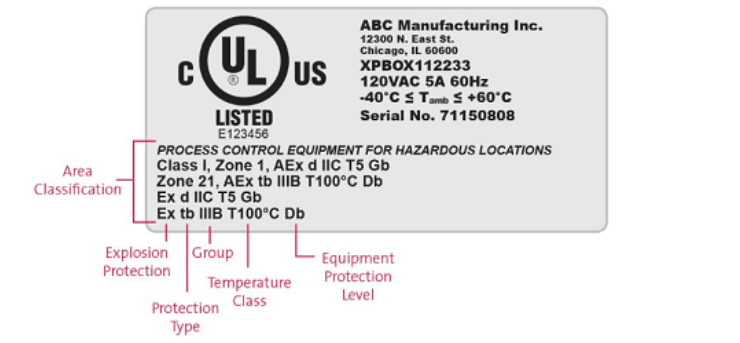
Image credited to UL – Underwriter’s Laboratories
Although each certification system has small differences, they all also have more similarities. The main difference is the geographical locations where the certification is recognized and accepted. While ATEX is a requirement in Europe and NEC is for the U.S., IEC Ex is accepted internationally across several member countries.
When it comes to hazardous zones in industrial processing areas, national and global regulations can be a complicated network to navigate. Our design and engineering team at Palamatic Process has 29 years of experience with supplying ATEX and NEC rated equipment to industries around the world. With over 2,000 installations in more then 30 countries, let our team of experts help navigate you through your industrial equipment and bulk material handling projects. Contact us today to learn more and together, find the right solution for your facility!














